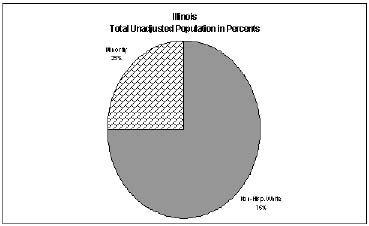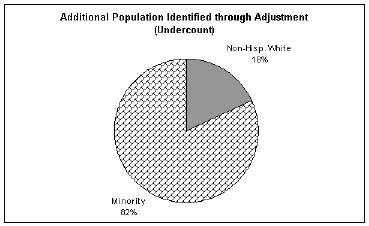State-by-State Analysis: Illinois
The
1990 undercount and its demographic composition
As
indicated in Table 1, the percentage undercount of 1.0 percent in Illinois
was lower than the national average of 1.6 percent and resulted in a net
numerical undercount of 113,717 persons, eight highest in the nation. For
non-Hispanic whites, Table 1 indicates, the undercount percentage was extremely
small, just 0.2 percent, as compared to 3.2 percent for members of minority
groups. As indicated in Table 2 and the summary Chart below, these differentials
between whites and minorities resulted in an undercounted population with
a much greater minority group percentage than the state's total population.
Minorities comprised 25 percent of the state's uncorrected population, compared
to 82 percent of the state's undercounted population. In numerical terms,
the undercount consisted of 20,688 non-Hispanic whites and 93,029 members
of minority groups. In Illinois a majority of minority group members are
non-Hispanic blacks, but the minority population is diverse. According to
corrected data, 58 percent of minority group members in Illinois are non-Hispanic
blacks, 31percent are Hispanics, and 10 percent are members of other minority
groups.


Implications of
1990 Census adjustment for minority voter opportunities
The use of
corrected data in Illinois for the post-1990 redistricting would have had
the potential to enhance minority voter opportunities in the plans drawn
for the State Senate and State House of Representatives. These opportunities
would be centered on Cook County (which includes the City of Chicago), where
the Illinois undercount is most heavily concentrated. In the Illinois State
Senate, the use of corrected data would have enhanced minority voter opportunities
by increasing the baseline of majority-minority districts against which
the next redistricting plan will be measured. State Senate District 17,
located in Cook County in the post-1990 plan, includes a minority population
of 49.6 percent. However, application of the corrected data for 1990 demonstrates
that the minority population of this District is more accurately measured
at 50.5 percent, clearly placing this district above the 50 percent mark.
There is also
sufficient undercounted population in Cook County to create the potential
to have drawn other districts with enhanced minority populations. Examples
include Senate District 9 (44.9 percent minority) and Senate District 11
(39.8 percent minority). The undercount in Cook County alone comprised some
81,000 persons, 72 percent of the total state undercount. Moreover, some
72,000 of the undercounted persons in Cook County (88 percent) are members
of minority groups, mostly Hispanics and blacks. This additional population
was more than would have been needed to meet one-person, one-vote requirements
in this region, given that the use of corrected data would have increased
the size of an ideal State Senate district by some 1,900 persons (from 193,739
to 195,666).
In the Illinois
State House, the use of corrected data would have enhanced minority voter
opportunities by increasing the baseline of majority-minority districts.
In the Illinois State House, several districts in Cook County in the post-1990
plan are close to 50 percent minority according to uncorrected census data.
House District 17 includes a minority population of 49.4 percent. However,
application of the corrected data for 1990 demonstrates that the population
of this District is more accurately measured at 50.6 percent, clearly above
the 50 percent mark. House District 33 includes a minority population of
49.9 percent. However, application of the corrected data for 1990 demonstrates
that the population of this District is more accurately measured at 50.7
percent, clearly above the 50 percent mark. Finally, House District 34 includes
a minority population of 49.2 percent. However, application of the corrected
data for 1990 demonstrates that the population of this District is more
accurately measured at 50.3 percent, clearly above the 50 percent mark.
The use of
corrected rather than uncorrected data might also have resulted in the drawing
of districts that enhanced the minority population of State House District
18 (40.5 percent minority), also in Cook County. Given that in Illinois
there are 118 House Districts as compared to 59 Senate districts, House
districts are about half as populous as Senate districts. The ideal size
of a State House district is about 96,870 persons for uncorrected data and
about 97,833 persons for corrected data, a net increase of just 963 persons.





